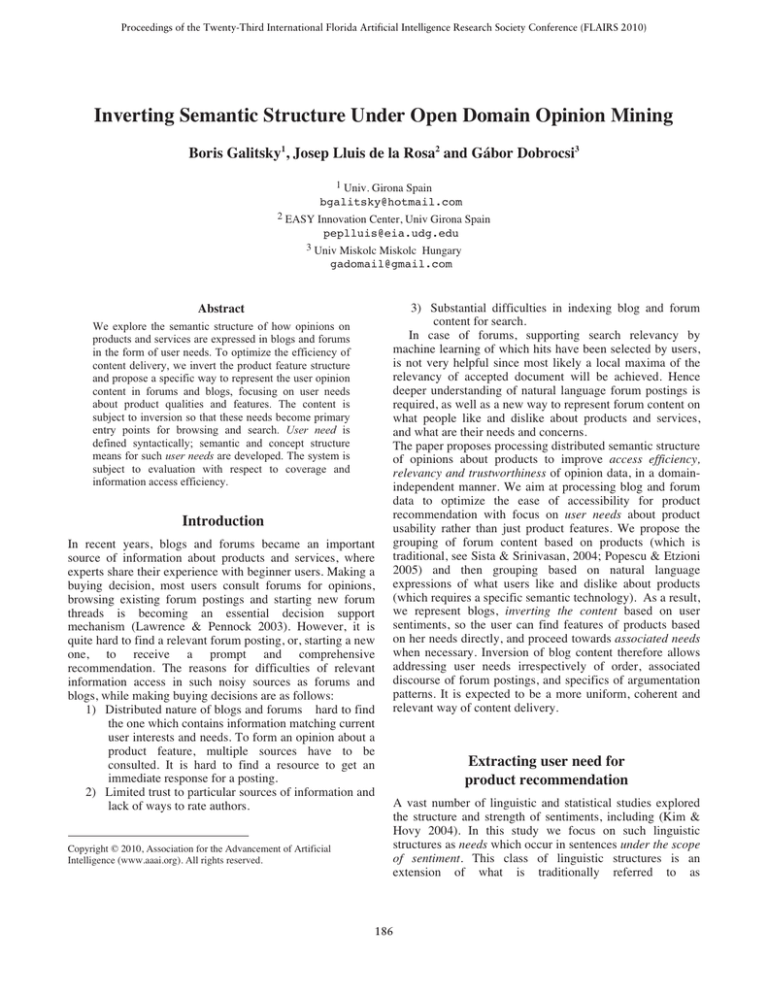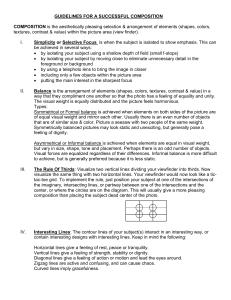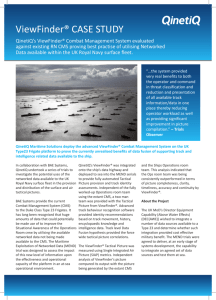
Proceedings of the Twenty-Third International Florida Artificial Intelligence Research Society Conference (FLAIRS 2010)
Inverting Semantic Structure Under Open Domain Opinion Mining
Boris Galitsky1, Josep Lluis de la Rosa2 and Gábor Dobrocsi3
1 Univ. Girona Spain
bgalitsky@hotmail.com
2 EASY Innovation Center, Univ Girona Spain
peplluis@eia.udg.edu
3 Univ Miskolc Miskolc Hungary
gadomail@gmail.com
Abstract
We explore the semantic structure of how opinions on
products and services are expressed in blogs and forums
in the form of user needs. To optimize the efficiency of
content delivery, we invert the product feature structure
and propose a specific way to represent the user opinion
content in forums and blogs, focusing on user needs
about product qualities and features. The content is
subject to inversion so that these needs become primary
entry points for browsing and search. User need is
defined syntactically; semantic and concept structure
means for such user needs are developed. The system is
subject to evaluation with respect to coverage and
information access efficiency.
Introduction
In recent years, blogs and forums became an important
source of information about products and services, where
experts share their experience with beginner users. Making a
buying decision, most users consult forums for opinions,
browsing existing forum postings and starting new forum
threads is becoming an essential decision support
mechanism (Lawrence & Pennock 2003). However, it is
quite hard to find a relevant forum posting, or, starting a new
one, to receive a prompt and comprehensive
recommendation. The reasons for difficulties of relevant
information access in such noisy sources as forums and
blogs, while making buying decisions are as follows:
1) Distributed nature of blogs and forums hard to find
the one which contains information matching current
user interests and needs. To form an opinion about a
product feature, multiple sources have to be
consulted. It is hard to find a resource to get an
immediate response for a posting.
2) Limited trust to particular sources of information and
lack of ways to rate authors.
Copyright © 2010, Association for the Advancement of Artificial
Intelligence (www.aaai.org). All rights reserved.
3) Substantial difficulties in indexing blog and forum
content for search.
In case of forums, supporting search relevancy by
machine learning of which hits have been selected by users,
is not very helpful since most likely a local maxima of the
relevancy of accepted document will be achieved. Hence
deeper understanding of natural language forum postings is
required, as well as a new way to represent forum content on
what people like and dislike about products and services,
and what are their needs and concerns.
The paper proposes processing distributed semantic structure
of opinions about products to improve access efficiency,
relevancy and trustworthiness of opinion data, in a domainindependent manner. We aim at processing blog and forum
data to optimize the ease of accessibility for product
recommendation with focus on user needs about product
usability rather than just product features. We propose the
grouping of forum content based on products (which is
traditional, see Sista & Srinivasan, 2004; Popescu & Etzioni
2005) and then grouping based on natural language
expressions of what users like and dislike about products
(which requires a specific semantic technology). As a result,
we represent blogs, inverting the content based on user
sentiments, so the user can find features of products based
on her needs directly, and proceed towards associated needs
when necessary. Inversion of blog content therefore allows
addressing user needs irrespectively of order, associated
discourse of forum postings, and specifics of argumentation
patterns. It is expected to be a more uniform, coherent and
relevant way of content delivery.
Extracting user need for
product recommendation
A vast number of linguistic and statistical studies explored
the structure and strength of sentiments, including (Kim &
Hovy 2004). In this study we focus on such linguistic
structures as needs which occur in sentences under the scope
of sentiment. This class of linguistic structures is an
extension of what is traditionally referred to as
186
features/topics in literature on opinion mining, towards a
general notion of user needs and product usability.
In this paper we are concerned with accurate extraction
and aggregation of individual user need expressions (review
quote). When purchasing online, consumers are interested in
researching the product or service they are looking to
purchase. Currently, this means reading through reviews
written on websites of different vendors that happen to offer
the product or service. For example, if the consumer is
interested in purchasing a digital camera, several on-line
vendors allow consumers to post reviews of cameras on the
website. Gathering information from such reviews is a
discouraging process nowadays as there is little way to sort
the reviews for the features that are of interest to any one
potential buyer so the potential buyer must read through
them manually. Sometimes reviewers rate a product with a
given number of stars in addition to making comments.
An average high or low number of stars is not necessarily
very informative to a potential buyer, especially if he or she
is especially concerned about certain features on the camera.
For example, a potential buyer may want a camera from
which the photographs come out with very true colors as
opposed to oversaturated colors. Other features, such as the
weight of the camera or the complexity of the controls are of
lesser concern to this potential buyer. A review with many
stars may explain the ease of changing batteries of the
camera and a review of few stars may complain that the
camera only has a 3X optical zoom. Neither of these
reviews is relevant to the potential buyer. In order to
determine that however the potential buyer must wade
through comments, if any, provided by the reviewer that
explain why the reviewer scored the. We need a method
which would allow for, in addition to the overall sentiment
and topic determination, local extraction to determine a
specific quote from the analyzed forums and blogs that
include the sentiment about that topic. Such a quote would
be essential for product recommendation, to serve as an
argument for why this particular product is recommended.
Inversion of content
In this section we define the inversion of content for a blog,
forum, or aggregated collection of opinions for a product. In
various sources of opinions, in different postings about an
entity such as digital camera, we combine the textual
expressions about a particular need of product users Subject,
occurring with various parameters in ParameterList1. Our
goal is to automatically represent the content in the way
grouped by Needs, where a content entry will be Need with
ParameterList. The intended transformation can be
illustrated in Fig. 1.
Posting1 Forum1
ParameterList1)
Posting1 Forum2
ParameterList2)
Posting2 Forum1
ParameterList3)
Posting2 Forum2
ParameterList4)
:
Sentiment
1
Need(Subject,
:
Sentiment
2
Need(Subject,
:
Sentiment
3
Need(Subject,
:
Sentiment
4
Need(Subject,
Subject ParameterList1 : Posting1 Forum1
ParameterList2 : Posting1 Forum2
ParameterList3: Posting2 Forum1
ParameterList4: Posting2 Forum2
Fig. 1: Illustration for the inversion of content based on user
needs.
We now illustrate inversion of content taking into account
posting by authors a∈A about needs f∈F of products p∈P,
Fig. 2.
A typical posting is a request to share information,
response to such request or opinion sharing without request,
mentioning how is the author related to product domain,
whether he likes / dislikes the product itself, its parameter,
feature or a particular need, and usability for particular
purpose:
Responding to a request:
I am a beginner user of a digital camera.
I enjoyed its zoom because it allows taking shots of
mountains.
I used it for outdoor
Notice that all italicized expressions are user needs
associated with particular product, including product
features and their usability. We use graphs to represent in
which form this kind of information is available to readers of
blogs and forums.
On the left of Fig. 2, the original graph for information
distributed through blogs and forums is shown. From right to
left, authors (nodes a1, a2 and a3) are sharing their opinions
on products (nodes p1…p5). Each ‘opinion sharing’ arc is
associated with a posting above and is labeled with the
content of opinion, a few need expression from the set
{f1…f6}. Needs occur in labels of arcs under positive (f1) or
negative (-f1) sentiment. {f1…f6} are raw features as
expressed by authors. These features are obtained by
extracting need expression from text by finding their
boundaries; no modification/rephrasing is applied. This
original graph reflects the original semantic structure of
information submitted by various authors with different
product needs and various reputations.
187
night picture (general, overall taking pictures at night)
night>cloud (how to film clouds at night),
night>cold (how to film at night in cold conditions
night>recommend (which measures are recommended at
night, general issues)
night>dark (filming in dark conditions)
night>set (what and how needs to be set)
night>inconsistent (for some cameras, setting seemed
inconsistent to some users)
night>shot (peculiarities about night shot)
night>tripod (use of tripod at night)
night>mode(switch to specific filming modes for night shots)
Fig. 2: The graph for original and user need-centric inverted
content.
On the right of Fig. 2, the graph for the inverted semantic
structure of forum and blog data is shown. This is a user
need
centric representation, where information is
‘digested’ and converted into a form ready to ‘consume’
opinions. The inverted graph have the same set of nodes for
products p1…p5. Now the fact the product p has a feature or
need F is expressed by the arc (F, p) of the right graph.
Under the process of content inversion, F is a derived from
the raw feature f from the original (left) graph by a series of
transformations described in the rest of this paper, including
rephrasing of natural language expression, extraction
linguistic patterns, grouping similar needs, finding consistent
set of needs and others. Hence the mapping from the original
graph to inverted graph converts a-nodes with f-labels into
new F-nodes from the derivatives of f. F-nodes are
constructed in a way allowing categorization of needs.
Extracting user needs from text
In study we are interested in how users express their needs
about products and services, so we can extract the needs as
natural language expressions and then in a formalized way,
suitable for grouping. User ‘needs’ are semantic structures,
but we need a set of syntactic constraints to be applied to
text for the purpose of extraction (Galitsky 2003).
These syntactic constraints turn out to be attachment to a
sentiment expression. To express them, we need to use
syntactic tree, where both vertices (lemmas) and edges
(syntactic links) are labeled. In a sentence, we first identify
sentiment as a vertex (single word like ‘good’, or subtree
‘did not work for me’) and then proceed to the sub-tree
which is dependent (linked to) the main vertex in sentiment
sub-tree. Over the years, we accumulated our own domainindependent vocabulary of English sentiments, coded as
parsing sub-trees to be identified at parsing trees (compare
with Sista & Srinivasan 2004).
Let us consider the domain of digital cameras, and focus
on a particular class of usability needs associated with taking
pictures at night. We use a pair of tags: night + specific
night-related need sub-category:
As one can see, the meanings for needs of filming at
night vary in generality and semantic roles, and phrasings
include nouns, adjectives and verbs. So the criteria of being
a user need indeed have to be formulated in terms of a subtree, satisfying certain syntactic (tree) conditions (see
Galitsky 2006 for more details).
For a horizontal (unlimited) domain (like electronics,
which is rather wide), all terms from need expressions
cannot be defined in an ontology. Therefore, semantics of a
need expression has to be inferred from the syntactic one.
Our assumption is that if there is at least one author who
attaches sentiment to an expression (which we know now as
an expression for need), then other people might have the
same need, so it is worth storing and analyzing. In terms of
syntactic tree, if a lemma for sentiment is dependent of a
term T and does not have its own dependent vertices, the
need expression is a sub-tree dependent on T.
Examples of extraction of two need expressions are
shown at Fig. 3. For the sentiment ‘great’, we have a subtree ‘in-daylight-bright’ which is a need expression (use of
digital cameras can be ‘great’, or ‘not so good’ in ‘bright
daylight’. For the sentiment ‘not…good’, we have a need
‘indoor-in-setting-dim. In the latter case sentiment is
expressed by ‘don’t expect it to get good’, where the main
vertex is ‘be’, and the need expression is branching from the
vertex ‘get’.
One needs to differentiate user needs and product features
(as presented by manufacturer or retailer). All product
features are assumed to be subjects of need, but not
otherwise. In terms of natural language, product features and
needs are phrased differently. For example, where user need
is expressed like ‘suited for small fingers’, a manufacturer
would write ‘1/4 inch button size’.
Content inversion
After need expressions are extracted, they need to be
normalized and grouped. Normalization transforms need
expressions into sequences of words in normal form, without
prepositions and articles. After that, need expressions are
grouped by the main noun of expression (the closest noun to
the trunk of the need expression as a sub-tree).
188
Fig. 3: Syntactic parse tree for sentences about digital camera with two pairs of sentiment-need expressions (circumscribed).
Let us consider an example of a group with noun
viewfinder, with the second word in grouped expression,
all keywords in need expression, and original sentence:
viewfinder>bright | bright setting optical viewfinder |
When you're in a very bright setting, the optical viewfinder
can be much easier to use than the LCD display
viewfinder>electronic |big fan electronic viewfinder |
have never been a big fan of Electronic Viewfinders
viewfinder>large| big viewfinder | this nice big viewfinder
doesn’t have the greatest resolution and it becomes totally
useless in bright light leaving you to have to rely on the
optic
viewfinder>lcd | display viewfinder lcd | You can change
the display from the viewfinder to the LCD which is a nice
feature too
Hence we have four need sub-categories {bright,
electronic, large, lcd} for the need category viewfinder.
These subcategories categorize viewfinder from very
different aspects. Notice that both syntactic relations
between viewfinder and second word varies, as well as
semantic relations, however we ignore that for the sake of
forming categories and sub-categories.
Four sentences above come from different sources, the
common thing between them is the product and a category
of user needs about viewfinder in connection to this
product.
viewfinder bright | bright setting optical viewfinder |
When you're in a very bright setting, the optical viewfinder
can be much easier to use than the LCD display
viewfinder electronic |big fan electronic viewfinder | have
never been a big fan of Electronic Viewfinders
viewfinder large| big viewfinder | this nice big viewfinder
doesn’t have the greatest
resolution and it becomes
totally useless in bright light leaving you to have to rely on
the optic
viewfinder lcd | display viewfinder lcd | You can change
the display from the viewfinder to the LCD which is a nice
feature too +
resolution high|high resolution | Pix quality very good,
usually shoot at highest resolution
resolution megapixel | megapixe camera produce
resolution | this 3 megapixel camera produces all the
resolution you need and more unless you are intent on
making posters
resolution pixel |resolution pixel | As a comparison,
the average 19 LCD computer monitor has a maximum
Fig. 4: Drilling in associated category of needs
189
Evaluation
We obtained a few thousand reviews per 100+ digital
camera products, built the index for need entries, and
provided a basic user interface for browsing and search.
The main questions for evaluation are:
1) Coverage: what percentage of user needs can be
identified, given the available set of reviews and
inversion of this set, implemented in this project
(Table 2);
2) Efficiency: how fast (how many steps) it is
necessary to find the relevant need entry and get
the sentence which describes it (Fig. 5).
Coverage evaluation for 5 queries and averages for another
set of 100 queries is shown in Table 1.
To properly interpret accessibility efficiency of the
inversion of content, the number of ‘steps’ should be
compared with the number of sentences user would have to
read in the body of reviews to reach the sentence which
would directly address the user interest. In real life,
number of such sentences (including review titles, section
titles and directory content) might easily reach 30-50.
To evaluate the relevancy of extracted need expression,
we built the need-based search framework. In this
framework search query is formulated as a certain
#
sub-categories
explored
Total number of steps
% satisfaction
of
Query (expression
interest)
‘Add lens like
lens-filter’
‘Self-timer
and
flash modes’
‘Rotate
LCD
screen in a variety
of positions’
‘Options
to
increase sharpness
and saturation’
‘Increase ISO to
stop
camera
shake’
100 queries (on
average)
# of need categories
explored
expression of a user needs about particular features and
usability of a product a service, such as ‘what kind of cell
phone is good for large-size fingers’, ‘… best fits my palm
…’. The recall and precision of answers are measured from
the standpoint of proper match of needs (Obviously, proper
match of need assumes proper identification of products
and features themselves). Preliminary estimate of Fmeasure for such search is above 80% for few product
domains processed so far.
Whereas category noun is identified by a rule, a subcategory word is obtained by clustering category into
clusters; sub-category word should not be a category word
and should occur in more than one need expressions within
a category. For more accurate identification of subcategory word more advanced methods could be used,
combining machine learning and statistical analysis; it
could produce higher percentage of word pairs where
meaning can be obtained just from this pair.
Inversion of content is a transformation of corpus of text
to a set of interactive textual components where each
component includes all content about given need for a
given product. These components are hyperlinked to drill
in and out of need categories associated with each other.
Let us now draw a hypothetical information access
scenario (Fig. 4). If a user is interested in how good is a
viewfinder for a given digital camera, all relevant entries
are grouped: user can either browse by his need or search
by it. Now imagine user got information above, read it and
now got interested in ‘which viewfinder has a better
resolution?’.
When the user (reader) indicates that he is interested in
‘viewfinder large’ full sentence ‘… resolution…’,
the system proceeds to the list of needs for the category
‘resolution’. If ‘resolution’ is not a category but a subcategory, the system would proceed to the respective subcategory (fewer entries). Otherwise, if ‘resolution’ occurs
in a need expression, such expression will be shown.
Finally, if ‘resolution’ does not occur in any expression,
the system retreats to keyword search. This content
exploration scenario might be associated with ‘hyperlinked
text’; in our case hyperlinks and pages are dynamic.
2
3
3
80
4
5
5
60
2
2
2
80
2
2
2
100
1
3
3
70
2.5
3.2
2.8
82%
Table 1: evaluation results
It is quite hard to compare the current results with stateof-art sentiment and topicality extraction because of the
way customer needs are defined. Therefore we do not
provide the sentiment extraction results here.
Proposed technique has been implemented providing
travel recommendations, based on review quotes. In
addition to hotel amenities available on current hotel
search websites, such need categories as kid-friendliness,
pet-friendliness, romance and impressive nightlife are
extracted from text and automatically formed
(uptake.com).
Conclusions
In this work we performed extraction from text and
reasoning about rather general, complex, and abstract
object such as user needs about products. This study
follows along the line of a body of work about sentiment
and polarity analysis (Popescu & Etzioni 2005, Lawrence
& Pennock 2003).
190
accessibility, compared to conventional browsing and
search at social web sites.
The existing research in the area of opinion mining is
mainly at the document level, to classify each whole
document as positive or negative for particular product
feature. In this study, since the user need defined
syntactically in terms of a sub-tree, opinion mining can be
conducted in an arbitrary domain. To perform the
sentence-level inversion of content, sentiments had to be
identified individually for proper feature-based grouping of
opinions on products. Having defined inversion of content
as a formal graph-based transformation, we implemented
the systematic and deterministic way of merging similar
opinions on the same product features.
We generalized the notion of feature extraction towards
need extraction, which required more sophisticated
linguistic analysis means due to significant variability of
linguistic parameters for the latter. Feature extraction
suffices part-of-speech information, but to circumscribe
need expression, full parsing tree is required with detailed
labels for nodes and arcs, as well as semantic rules which
navigate these trees (Galitsky 2003).
Acknowledgements
This research is funded by the European Union project
Num. 216746 PReservation Organizations using Tools in
AGent Environments (PROTAGE), FP7-2007- ICT
Challenge 4: Digital libraries and content, European Union
project Num. 238887, a unique European citizens’
attention service (iSAC6+) IST-PSP, SIE 2007 Motor
intelligent de recuperació i processament semàntic
d’informació en base a criteris de personalització, as well
as RDiSAC Recerca en incentivació de la participació 2.0
i llenguatge natural per contexts per a la creació de
serveis no presencials d'informació i atenció ciutadana
SAC, a grant from ACC1O Catalan Government, as well
as the CSI-ref.2009SGR-1202 consolidate research group.
References
Popescu, A., Etzioni, O. Extracting Product Features and
Opinions from Reviews. Proc. Joint Conf. on Human Lang.
Tech. / Conf. on Empirical Methods in Natural Lang.
Processing, 339-346 (2005).
Sista, S., Srinivasan, S. Polarized Lexicon for Review
Classification. Proc. Intl. Conf. on Machine Learning,
Models, Technologies & Applications (2004).
Allen,
J.
Natural
Language
Understanding.
Benjamin/Cummings (1995).
Galitsky, B. Merging deductive and inductive reasoning
for processing textual descriptions of inter-human
conflicts. J Intelligent Info Systems, v27, N1, 21-48
(2006).
Galitsky, B. Natural Language Question Answering
System: Technique of Semantic Headers. Advanced
Knowledge International, Australia (2003).
Melucci, M., Rehder, J. Using Semantic Annotations for
Automatic Hypertext Link Generation in Scientific Texts
Proceedings of the Workshop on Semantic Web
Technologies (2003).
Lawrence, S., Pennock, D. Mining the Peanut Gallery:
Opinion Extraction and Semantic Classification of Product
Reviews. Proc. 12th Intl. Conf. on World Wide Web, 519528. (2003).
Valitutti, A., Strapparava,C. and Stock, O. Developing
Affective Lexical Resources. PsychNology Journal,
2(1):61–83 (2004).
Hu, M. and Liu, B. Mining and summarizing customer
reviews. In KDD-04, pp 168–177. (2004).
Kim, S.-M. and Hovy, E. Determining the sentiment of
opinions. In COLING-2004, pp 1367–1373, Geneva,
Switzerland (2004).
Pang, B. and Lee, L. Seeing stars: Exploiting class
relationships for sentiment categorization with respect to
rating scales. In Proceedings of ACL-2005 (2005).
Fig. 5: How fast the user need of interest can be achieved.
Inversion of content can be considered as a semanticbased hypertext generation, quite popular a decade ago
(Melucci & Rehder 2003). Automated linking based on
lexical and content analysis, which also can be used to
determine similarities (relationships) among documents,
has been studied. Hypertext functionality includes
navigational, annotation, structure-oriented and vieworiented features; however, from the standpoint of given
paper automated linking creates static links, unlike the UI
presented here.
We observed that inversion of content is an efficient
way to access user-generated information in forms of
forums and blogs. It is quite obvious that grouping
information around entities of interest such as laptops if
fruitful for information access and decision support for
intended products’ features. In this study we proceeded
from grouping by entities to grouping and clustering by
needs, to accelerate the information access in such area as
users’ opinions.
Preliminary evaluation showed that proposed approach
to semantic-based information access to public opinions
provides satisfactory coverage as well as efficient
191








